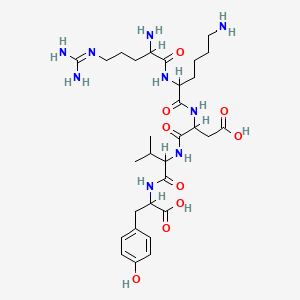
Synopsis
Synopsis
0
USDMF
0
CEP/COS
0
JDMF
0
EU WC
0
KDMF
0
NDC API
0
VMF
0
FDA Orange Book

0
Canada

0
Australia

0
South Africa

DRUG PRODUCT COMPOSITIONS
0
US Patents
0
US Exclusivities
0
Health Canada Patents
0
API
0
FDF
0
Data Compilation #PharmaFlow
0
Stock Recap #PipelineProspector
0
Weekly News Recap #Phispers
0
News #PharmaBuzz


1. Pentapeptide, Thymopoietin
2. Thymopentin
3. Timunox
4. Tp-5
1. 69558-55-0
2. Ncgc00166412-01
3. Specplus_000687
4. Spectrum4_001271
5. Arg-lys-asp-val-tyr-oh
6. Thymopentin Acetate(tp-5)
7. Thymopoietin Ii-32-36)
8. Kbiogr_001882
9. Divk1c_006783
10. Schembl989519
11. Chembl1868258
12. Kbio1_001727
13. Dtxsid10860899
14. Hms3369g09
15. (3s)-3-[[(2s)-6-amino-2-[[(2s)-2-amino-5-(diaminomethylideneamino)pentanoyl]amino]hexanoyl]amino]-4-[[(2s)-1-[[(1s)-1-carboxy-2-(4-hydroxyphenyl)ethyl]amino]-3-methyl-1-oxobutan-2-yl]amino]-4-oxobutanoic Acid
16. Nsc645363
17. Akos015961651
18. Akos026750555
19. Ac-8959
20. Nsc-645363
21. As-13028
22. Dl-arginyl-dl-lysyl-dl-aspartyl-dl-valyl-dl-tyrosine
23. J-011348
24. N~5~-(diaminomethylidene)ornithyllysyl-alpha-aspartylvalyltyrosine
25. L-tyrosine, N-[n-[n-(n2-l-arginyl-l-lysly)-l-.alpha.-aspartyl]-l-valyl]-
| Molecular Weight | 679.8 g/mol |
|---|---|
| Molecular Formula | C30H49N9O9 |
| XLogP3 | -6.4 |
| Hydrogen Bond Donor Count | 11 |
| Hydrogen Bond Acceptor Count | 12 |
| Rotatable Bond Count | 22 |
| Exact Mass | 679.36532417 g/mol |
| Monoisotopic Mass | 679.36532417 g/mol |
| Topological Polar Surface Area | 328 Ų |
| Heavy Atom Count | 48 |
| Formal Charge | 0 |
| Complexity | 1110 |
| Isotope Atom Count | 0 |
| Defined Atom Stereocenter Count | 0 |
| Undefined Atom Stereocenter Count | 5 |
| Defined Bond Stereocenter Count | 0 |
| Undefined Bond Stereocenter Count | 0 |
| Covalently Bonded Unit Count | 1 |
Adjuvants, Immunologic
Substances that augment, stimulate, activate, potentiate, or modulate the immune response at either the cellular or humoral level. The classical agents (Freund's adjuvant, BCG, Corynebacterium parvum, et al.) contain bacterial antigens. Some are endogenous (e.g., histamine, interferon, transfer factor, tuftsin, interleukin-1). Their mode of action is either non-specific, resulting in increased immune responsiveness to a wide variety of antigens, or antigen-specific, i.e., affecting a restricted type of immune response to a narrow group of antigens. The therapeutic efficacy of many biological response modifiers is related to their antigen-specific immunoadjuvanticity. (See all compounds classified as Adjuvants, Immunologic.)
Global Sales Information

REF. STANDARDS & IMPURITIES

ABOUT THIS PAGE
13
PharmaCompass offers a list of Thymopentin API manufacturers, exporters & distributors, which can be sorted by GMP, USDMF, JDMF, KDMF, CEP (COS), WC, Price,and more, enabling you to easily find the right Thymopentin manufacturer or Thymopentin supplier for your needs.
Send us enquiries for free, and we will assist you in establishing a direct connection with your preferred Thymopentin manufacturer or Thymopentin supplier.
PharmaCompass also assists you with knowing the Thymopentin API Price utilized in the formulation of products. Thymopentin API Price is not always fixed or binding as the Thymopentin Price is obtained through a variety of data sources. The Thymopentin Price can also vary due to multiple factors, including market conditions, regulatory modifications, or negotiated pricing deals.
A Thymopentin manufacturer is defined as any person or entity involved in the manufacture, preparation, processing, compounding or propagation of Thymopentin, including repackagers and relabelers. The FDA regulates Thymopentin manufacturers to ensure that their products comply with relevant laws and regulations and are safe and effective to use. Thymopentin API Manufacturers are required to adhere to Good Manufacturing Practices (GMP) to ensure that their products are consistently manufactured to meet established quality criteria.
click here to find a list of Thymopentin manufacturers with USDMF, JDMF, KDMF, CEP, GMP, COA and API Price related information on PhamaCompass.
A Thymopentin supplier is an individual or a company that provides Thymopentin active pharmaceutical ingredient (API) or Thymopentin finished formulations upon request. The Thymopentin suppliers may include Thymopentin API manufacturers, exporters, distributors and traders.
click here to find a list of Thymopentin suppliers with USDMF, JDMF, KDMF, CEP, GMP, COA and API Price related information on PharmaCompass.
Thymopentin Active pharmaceutical ingredient (API) is produced in GMP-certified manufacturing facility.
GMP stands for Good Manufacturing Practices, which is a system used in the pharmaceutical industry to make sure that goods are regularly produced and monitored in accordance with quality standards. The FDA’s current Good Manufacturing Practices requirements are referred to as cGMP or current GMP which indicates that the company follows the most recent GMP specifications. The World Health Organization (WHO) has its own set of GMP guidelines, called the WHO GMP. Different countries can also set their own guidelines for GMP like China (Chinese GMP) or the EU (EU GMP).
PharmaCompass offers a list of Thymopentin GMP manufacturers, exporters & distributors, which can be sorted by USDMF, JDMF, KDMF, CEP (COS), WC, API price, and more, enabling you to easily find the right Thymopentin GMP manufacturer or Thymopentin GMP API supplier for your needs.
A Thymopentin CoA (Certificate of Analysis) is a formal document that attests to Thymopentin's compliance with Thymopentin specifications and serves as a tool for batch-level quality control.
Thymopentin CoA mostly includes findings from lab analyses of a specific batch. For each Thymopentin CoA document that a company creates, the USFDA specifies specific requirements, such as supplier information, material identification, transportation data, evidence of conformity and signature data.
Thymopentin may be tested according to a variety of international standards, such as European Pharmacopoeia (Thymopentin EP), Thymopentin JP (Japanese Pharmacopeia) and the US Pharmacopoeia (Thymopentin USP).
